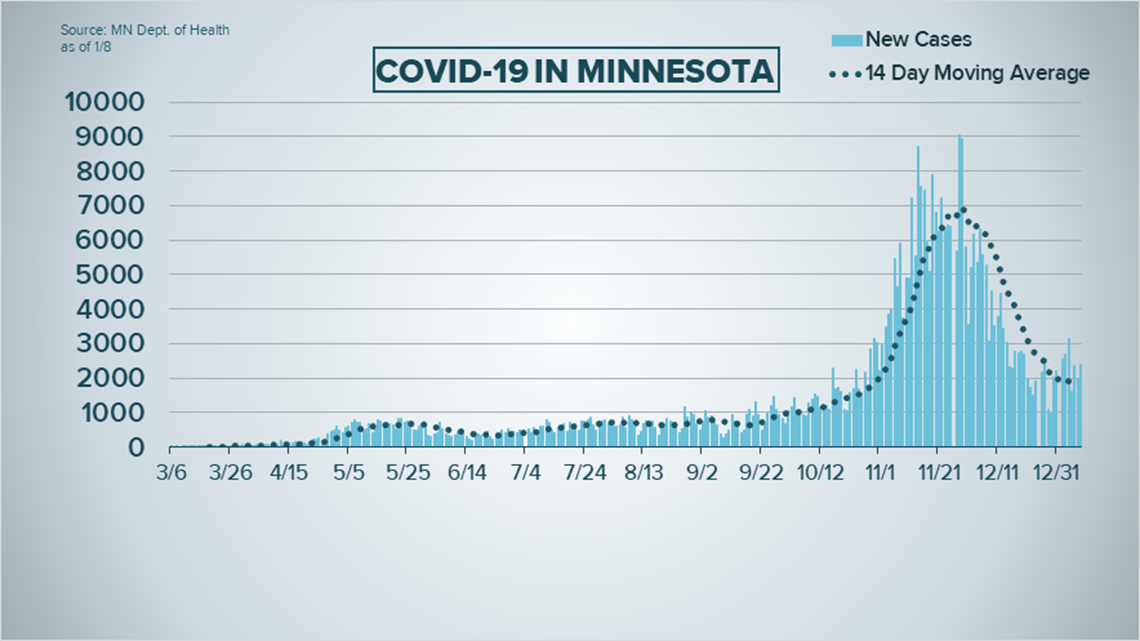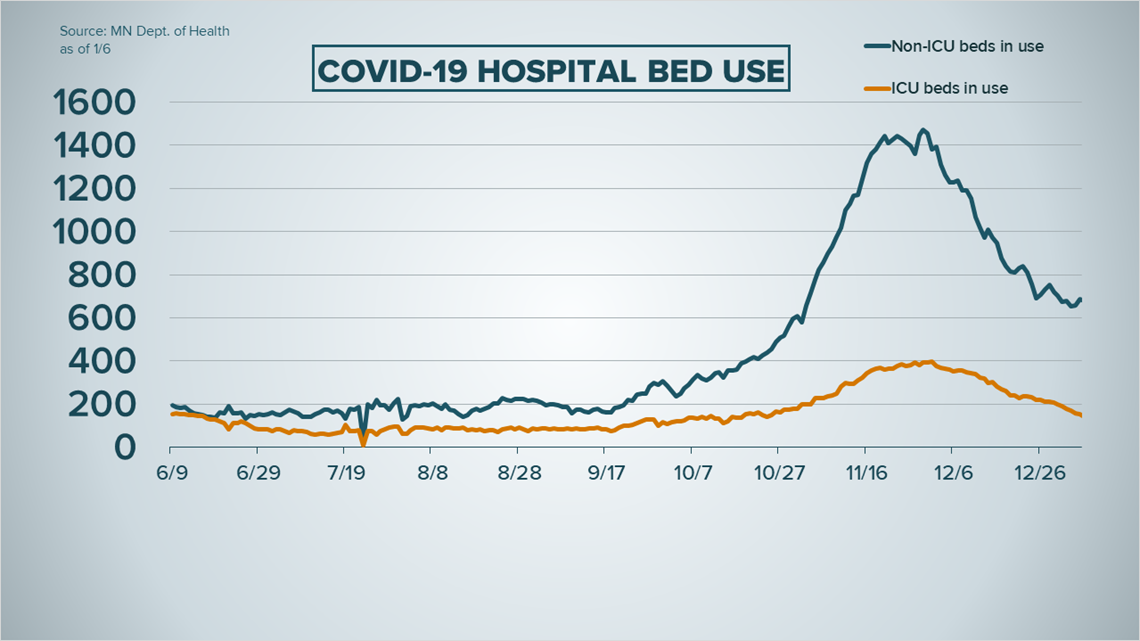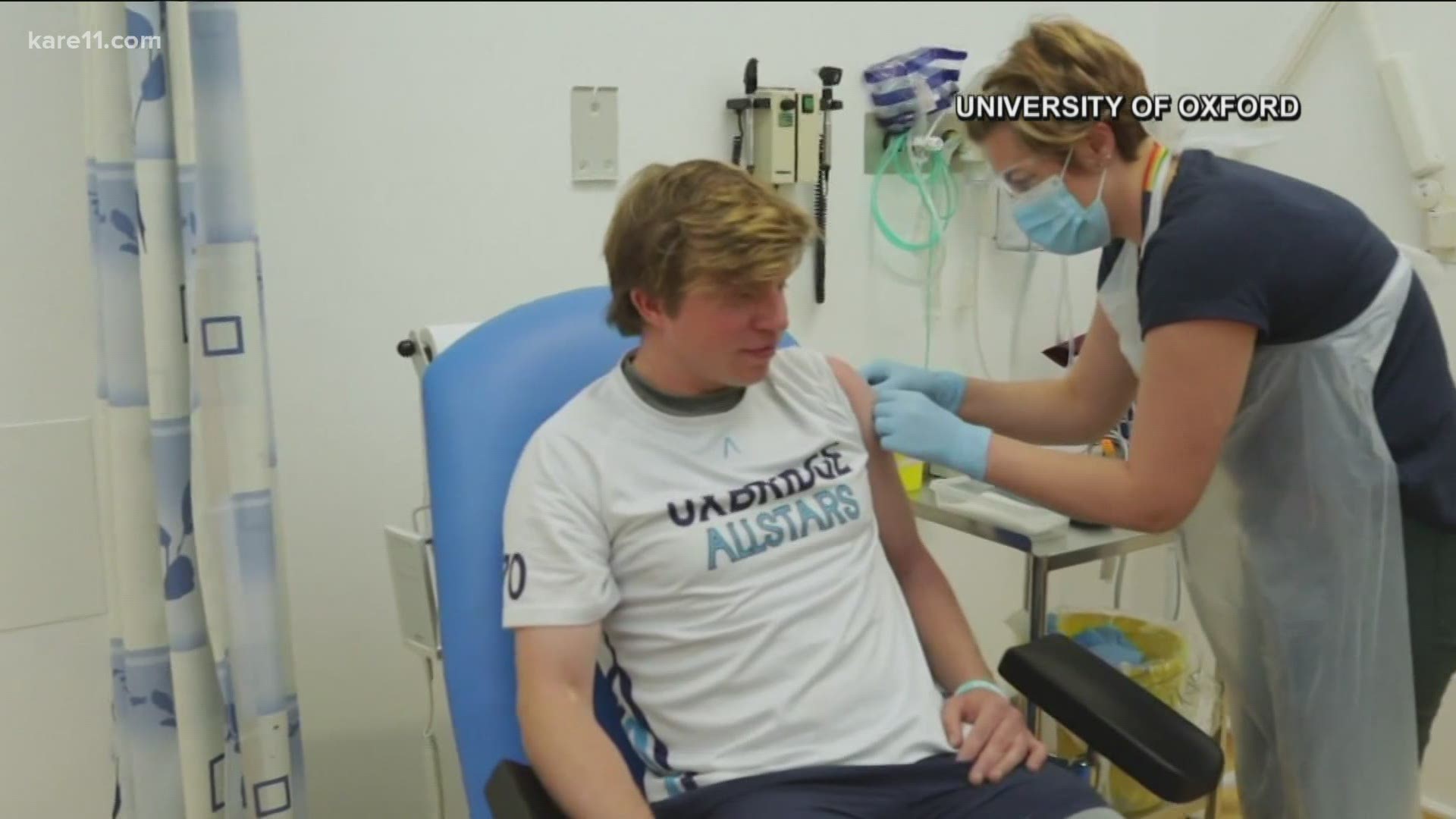ST PAUL, Minn. — Friday, Jan. 8
- Minnesota passes milestone with more than 100,000 people vaccinated
- Walz opens indoor bar, restaurant dining to 50% capacity starting Monday
- Health officials report 'bump' in COVID cases after holidays
- Minnesota still on target to finish Phase 1a by end of January
2 p.m.
On Friday afternoon, Governor Tim Walz toured a COVID-19 vaccine clinic at Wayzata High School, where EMS-certified first responders received the Moderna vaccine. After the tour, he and other officials took questions from the media.
Walz said that while Minnesota is moving in the right direction, "we are not out of the woods yet," with test positivity creeping up and a potential bump in cases from the holidays.
Still, as the dials are set to turn back around the state with relaxed restrictions on indoor activities such as dining, he added that he is grateful to see kids heading back to schools and into sports practices again.
Minnesota Department of Health Commissioner (MDH) Jan Malcolm addressed COVID-19 vaccinations in Minnesota. She estimated that the state will be working on vaccinating those in Phase 1a through most of January, and then hopes move into Phase 1b, which holds a population of over one million Minnesotans, in February.
Malcolm addressed the national conversation regarding limited vaccine supply, and whether more people should be vaccinated with the first dose, rather than conserving vaccine so they can fully inoculate fewer people with both doses. Malcolm said she believes that decision should not be made locally, and is looking to federal guidance.
She added that she is not sure when COVID-19 vaccines will be available to the general public, though she estimates it could be late spring or early summer.
Walz said he hopes the relaxed restrictions in Minnesota that go into effect on Jan. 11 will "strike the proper balance" of managing economic and public health needs in the state, though he acknowledged that his hand is staying on the dial.
"If we can reduce the risk... and our hospital numbers came way down, that it makes sense to move a little bit," he said. "But if those red flags start to fly in those healthcare systems, we will make those adjustments."
11 a.m.
COVID-19 deaths have shown no sign of receding in the past few days, and on Friday the Minnesota Department of Health (MDH) reported 48 more people have lost their lives to the virus.
The fatalities recorded in the past day bring Minnesota's total to 5,620 since the pandemic started. Of those deaths 3,605, or 64% of them, are linked to people in long-term care or assisted living settings.
MDH says 2,387 new cases were reported in the past day, bring the state's total coronavirus cases to 431,944. The new cases are based on results from 49,029 tests (43,978 PCR and 5,051 Antigen) processed in private and state lags. Health officials consider a positive PCR test a confirmed COVID case, while a positive Antigen test is considered a probable case.


Hospitalizations continue to trend downwards. As of Thursday 759 COVID-19 patients occupied hospital beds across the state, with 130 of them being treated in ICU beds. Occupancy rates in hospitals across the Twin Cities metro appear steady, with just 3.6% (133) of non-ICU beds open, and 7.1% (49) of ICU beds available. In total, 22,617 people have been hospitalized in Minnesota since the onset of the pandemic, with 4,742 in ICU.
At this point 409,727 people who have tested positive for the virus have recovered sufficiently to not require isolation.
Minnesota has also passed a notable milestone with more than 100,000 doses of vaccine administered. As of Friday 104,226 people have been vaccinated, and MDH officials say those numbers are ramping up.
Young adults still account for the most coronavirus cases in the state, with those 20 to 24 making up 43,704 cases and three deaths, while 25 to 29-year-olds are linked to 38,901 cases and six fatalities. The largest grouping of deaths involves people 85 to 89, with 1,059 fatalities in just 5,697 diagnosed cases.
Hennepin County has recorded the most COVID activity of any county in the state with 89,708 cases and 1,434 deaths, followed by Ramsey County with 38,539 cases and 713 deaths, Dakota County with 31,771 cases and 296 deaths, and Anoka County with 30,068 and 342 deaths.
Cook County in northeastern Minnesota continues to have the least activity with 109 cases.
Thursday, Jan. 7
2 p.m.
Minnesota health and employment officials held a regular media briefing call Thursday to give an update on COVID-19 spread and the continuing vaccine rollout across the state.
Minnesota Department of Health (MDH) Commissioner Jan Malcolm and Infectious Disease Director Kris Ehresmann spoke on the call, along with Department of Employment and Economic Development (DEED) Commissioner Steve Grove.
The call comes one day after Gov. Tim Walz's new executive order was announced, loosening restrictions on many businesses effective Monday.
Malcolm reported Thursday that the average hospital admissions daily are about one-third of what they were in Minnesota's November peak.
She also said MDH believes the numbers are reflecting a "bump" from the holidays. "We are seeing our weekly change in cases tick up over the prior week" after it had been consistently declining, she said. The test positivity rate is "inching upwards," Malcolm said, after going below 5% for a couple of days.
Malcolm said Gov. Tim Walz's announcement Wednesday to loosen restrictions on some Minnesota businesses starting Monday is a recognition of the progress made across the state recently.
She urged Minnesotans to continue to follow precautions including masking, social distancing and getting tested for COVID-19.
"It didn't really take long two months ago when the pandemic quickly hit that inflection point and snowballed from what had been a fairly manageable level of case growth to something that was really growing out of control and threatening hospital capacity," Malcolm said. "And we absolutely want to do everything we can to avoid that."
Malcolm said the new variant of COVID represents a "potential variable that's different" from what the state has been planning for.
"Were going to keep a very, very close eye on this," she said. "These next few weeks are critical to see if this gradual reopening strategy can sustain."
Malcolm said that the public health lab and some partners in Minnesota have the capability of screening for the new COVID-19 variant, and are doing so consistently. Not every lab in the state does, though.
Ehresmann said MDH is working in partnership with other labs to get samples and keep testing for the new variant.
DEED Commissioner Steve Grove spoke on Thursday as well. He said that there is a strong desire in the business community to work with the state in reopening safely. He contrasted that with some of the businesses that have defied the governor's order, opening without social distancing or masks and making headlines.
"They do not represent the lion's share of businesses in our state who are doing everything that they possibly can to protect their customers," he said.
Grove said there is "inherent risk" but that businesses want to protect the progress that's been made in Minnesota.
"We're optimistic but we do it with caution because we've seen now that things can change really quickly when compliance doesn't happen," he said.
MDH Infectious Disease Director Kris Ehresmann gave an update on the timeline of vaccinations being allocated and administered in Minnesota.
She said the state gets a weekly allocation of doses from the federal government, and is informed about that weekly allocation on Tuesdays.
Ehresmann said this week, MDH learned on Tuesday that the state's next allocation is 32,900 doses from Moderna and 33,150 from Pfizer. The health department is then able to place an order for those amounts on Thursday, and the doses arrive the next week. Once they arrive in Minnesota, they then have to be shipped to their final destination, where they will be administered.
"Shots are going into arms," Ehresmann said. "And there are aspects of this process that are out of our control, but our process is set up to keep vaccines moving as quickly and as efficiently as we can."
Ehresmann said she believes Phase 1a will be finished by the end of January, if allocations continue as they expect. She offered the caveat that she believes vaccinations even in the 1a group will be ongoing.
In total, there are 23,000 long-term care residents in skilled nursing facilities and 75,000 plus staff in Minnesota, Ehresmann said.
Ehresmann also said that when they move into the phases of vaccination that include people who are not in congregate care or specific employer groups, MDH will take the initiative to reach out.
"We will be doing outreach," she said. "It's not a situation where you have one chance to get vaccinated and if you miss it, you're out of luck. There will be much communication and many opportunities."
Many health care workers and pharmacists have been registered to vaccinate members of the public when the time comes, Ehresmann said, but they are not ready to implement that system yet.
11 a.m.
Minnesota's new COVID-19 cases remain flat while deaths remain higher after dropping into the teens in recent days, according to numbers released Thursday by the state Department of Health (MDH).
An additional 44 lives have been lost to the virus, bringing fatalities to a total of 5,572. Of those deaths 3,576, or 64% are associated with long-term or assisted living facilities.
MDH says 2,004 new coronavirus cases were reported in the past day, based on results from 42,049 tests (35,162 PCR, 6,887 antigen) processed in private and state labs. Health officials consider a positive PCR test a confirmed COVID case, while a positive antigen test is considered a probable case.


Minnesota has now recorded 429,570 COVID-19 cases since the start of the pandemic, of which 15,917 were identified by antigen tests.
The number of hospital beds in use to treat coronavirus patients continues to drop. As of Wednesday, the latest data available, 787 beds statewide were being used, with 135 of them in the ICU. That's down from 817 total COVID beds Tuesday. Availability of beds to treat patients in the Twin Cities metro remains an issue, with non-ICU beds currently 4% open. ICU bed availability is down to 6%.
Total hospitalizations now stand at 22,541 since the onset of COVID-19, with 4,733 of those patients requiring ICU treatment.


People in their 20s continue to account for the largest number of Minnesota's COVID cases, with those 20 to 24 recording 43,502 cases and three deaths, and 25 to 29-year-olds making up 38,660 cases and six deaths.
Health officials say 408,510 people who at one time tested positive for the virus no longer require isolation.
People from 85 to 89 are the largest grouping of the state's coronavirus deaths with 1,051 in 5,671 diagnosed cases.
Hennepin County has the most COVID activity in the state with 89,175 cases and 1,426 deaths, followed by Ramsey County with 38,352 cases and 710 deaths, Dakota County with 31,538 cases and 291 fatalities, and Anoka County with 29,922 cases and 339 deaths.
Cook County in northeastern Minnesota has experienced the least COVID activity with just 109 cases and zero fatalities.
KARE 11’s coverage of the coronavirus is rooted in Facts, not Fear. Visit kare11.com/coronavirus for comprehensive coverage. Have a question? Text it to us at 763-797-7215. And get the latest coronavirus updates sent right to your inbox every morning. Subscribe to the KARE 11 Sunrise newsletter here. Help local families in need: www.kare11.com/give11.
The state of Minnesota has set up a data portal online at mn.gov/covid19.

